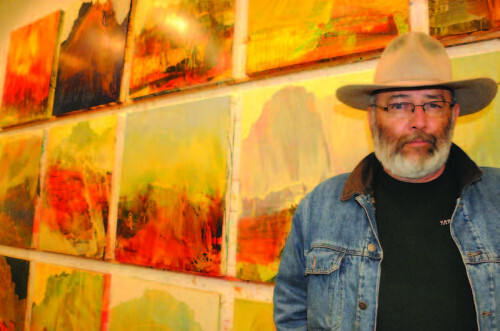James Lavadour
No discussion of landscape painting in the Pacific Northwest is complete without specific recognition of the indigenous people who are the original caretakers and recorders of the landscape.
In 1951, James Lavadour was born in Pendleton, Oregon into the Walla Walla tribe. He was long fascinated by the Blue Mountains of Eastern Oregon as he lived right be them and quickly became interested in the land and spent most of his time in nature. Lavadour never officially attended art school but was instead taught by the land, and as he grew as an artist, he was always more interested in the process of painting rather than content. The land inspired him with its unique formations, and as he learned from the earth, he replicated these formations and their processes in his art.
In the 1970s, Lavadour began to pursue art alongside tribal government, land management, and social services for the Umatilla Indian Reservation. Still, it wasn’t until the 1980s that he started exhibiting his work. And in 1992, he helped create the Crow’s Shadow Institute of the Arts (CSIA) which sought to “provide educational, social, and economic opportunities for Native Americans through artistic development…classes in traditional and contemporary arts, and it emphasizes the role art can play in Native communities as an economic and cultural resource,” as said in the book James Lavadour: Properties of Paint (3).
The CSIA is mainly a printmaking institute, and its focus on this art form is in part influenced by Lavadour’s education in printmaking and lithography from Eileen Foti who was trained at the Tamarind Institute at the University of New Mexico in Albuquerque- a hotspot for printmaking in the 1950s and 1960s. However, it is also recognized that printmaking allows Native American artists to continue their ancestors' artistic lineage as picture-making can be traced back to the beginning of people inhabiting this region. And while CSIA is for young Native American artists, a core value is cultural exchange; thus, artists of all cultures are welcome.
Lavadour is aware of this history and his interest and experience in printmaking has increased his understanding of layers that transfers to painting. His technique is spontaneous; he lets the paint decide where it wants to go and finds the image within it. He paints, pours, scrapes, and layers according to that philosophy because, as Lavadour said himself in James Lavadour: Properties of Paint, “a painting is not created, it is revealed… it means we are alive and we are connected in thought” (2).
In the Oregon Art Beat special “James Lavadour Update”, he said that while some more abstract artists recommend the viewer to look at the painting from far away to allow the image to come together, Lavadour wants viewers to touch his painting and feel their tactile nature. He believes art brings people together because we are all human, and the land connects everyone. His paintings look to this universality of the land, and his art thus becomes universal - the layering of paint simulates the layers of time the earth records that are not always visible to the human eye. Art helps us to understand, according to Lavadour, the complexity of nature, and his paintings -according to him- seek to awaken in viewers an innate memory all humans have about land.

